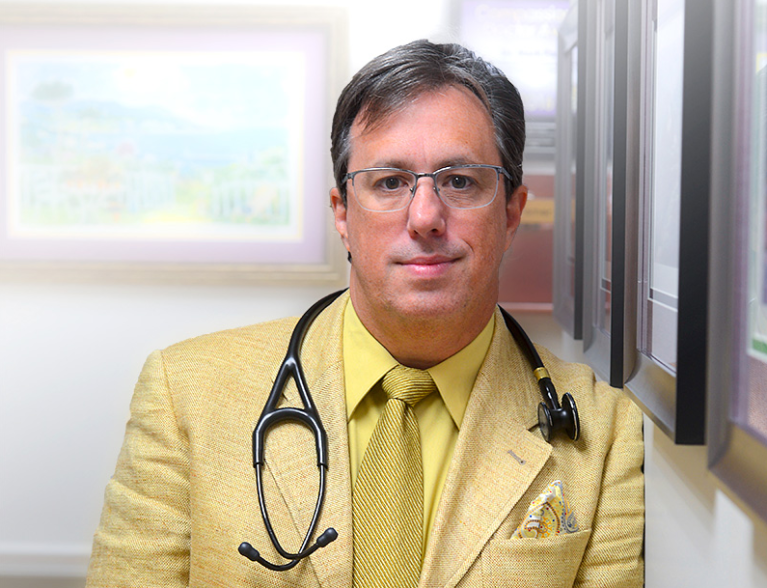
Chronic Obstructive Pulmonary Disease (COPD) is a progressive lung disease affecting millions of people worldwide. It’s caused mainly by long-term exposure to lung irritants that damage the airways and lung tissue.
Dr. Mark J. Pamer, D.O., a pulmonologist with offices in St. Lucie West, explains that the most common cause is smoking, which is behind the majority of cases. Other causes include exposure to air pollution, workplace dust and chemicals, secondhand smoke and some indoor pollutants.
According to the COPD Foundation, chronic lower respiratory diseases, including COPD, are the sixth leading cause of death in the United States.
Dr. Pamer says that in some cases genetics also play a role. A rare genetic disorder called alpha-1 antitrypsin deficiency (AATD) can lead to COPD, even in individuals who have never smoked.
“COPD is an umbrella term that includes several distinct respiratory conditions characterized by chronic airflow limitation,” says Dr. Pamer. “Primary diseases under the COPD umbrella are chronic bronchitis and emphysema.
“Chronic bronchitis is defined by the presence of chronic productive cough for at least three months in two consecutive years, while emphysema is characterized by the destruction of the air sacs and lung tissue.
“Additionally, COPD can include overlap conditions with other less common pulmonary conditions that present unique diagnostic and therapeutic challenges.”
As a pulmonologist, Dr. Pamer sees firsthand how COPD impacts patients’ lives, often causing them to struggle with daily activities.
“In emphysema, air gets trapped in the lungs, making it feel like you can’t fully breathe out.
Imagine blowing up a balloon but not being able to let the air out easily – this is similar to how COPD affects breathing. A simple task like carrying groceries, bending over, or making a bed can become exhausting,” he says.
“Sometimes, COPD symptoms suddenly get worse, which is called an ‘exacerbation,’ meaning there is more shortness of breath, more coughing and changes in mucus. Exacerbations are treated with steroids, inhalers, and sometimes antibiotics.”
The good news is that, while COPD can’t be cured, available treatments can help manage symptoms, slow disease progression, and improve quality of life.
The National Library of Medicine reports that treatments for COPD have increased substantially in the past 20 years with the introduction of new oral and inhaled medications as well as novel surgical and bronchoscopic procedures.
Dr. Pamer discusses them:
“Most patients with COPD benefit from a combination of medications (which are mainly bronchodilators), lifestyle changes and preventive measures, including vaccines. These treatments aim to open airways, reduce inflammation and prevent complications.
“Bronchodilators are medications that help relax the muscles around the airways, making it easier to breathe. There are two main types:
- Short-acting bronchodilators (e.g., albuterol and ipratropium bromide) provide quick relief for sudden shortness of breath.
- Long-acting bronchodilators (e.g., arformoterol, formoterol, vilanterol, salmeterol, olodaterol, tiotropium, glycopyrrolate, etc.) are used daily to maintain open airways and reduce symptoms over time.
“Inhaled corticosteroids (such as fluticasone) help reduce airway inflammation, making it easier to breathe. They are often prescribed in combination with long-acting bronchodilators for patients with frequent flare-ups.
“Pulmonary rehabilitation is a comprehensive program that includes exercise training, breathing techniques, and education about COPD management. Studies show that patients who participate in pulmonary rehab experience improved symptoms, fewer hospitalizations, improved stamina and a better overall quality of life.
“Oxygen therapy is for patients with severe COPD who have low oxygen levels in their blood and can be lifesaving. It helps prevent complications such as heart strain and improves overall energy levels.
“Annual flu vaccines, pneumococcal vaccines, RSV, and COVID-19 vaccinations are strongly recommended to prevent severe infections in patients with COPD.
“The one treatment that can truly change the course of COPD, is quitting smoking. Smoking is the primary cause of COPD, and stopping it can slow disease progression and improve lung function over time.
“For patients with advanced COPD who do not respond well to standard treatments, surgical options designed to reduce lung hyperinflation and improve breathing capacity may be considered. These therapies have also resulted in significant reductions in the frequence of COPD exacerbations.”
Surgical options include:
- Lung Volume Reduction Surgery (LVRS) involves surgically removing the most damaged parts of the lungs, allowing the other healthier sections to function more efficiently. This procedure can improve breathing mechanics and lead to significant improvements in shortness of breath and fewer COPD exacerbations. It is only suitable for select patients, usually those with emphysema in the upper lung regions.
- Endobronchial Valve Therapy is a less invasive alternative to LVRS. Endobronchial valves are tiny one-way valves placed in the airways during bronchoscopy. The valves prevent airflow into diseased emphysematous lung segments, which collapse as the air inside of them is absorbed into the blood supply. The valves cause airflow to be redirected to healthier lung areas.
This approach of collapsing the diseased segments and allowing better inflation of healthy lung tissue helps reduce lung overinflation and makes breathing easier for patients with severe emphysema. Historically, like LVRS, this procedure was done for patients who had emphysema mainly in the upper lobes. However, recently it is also being performed for patients who have significant hyperinflation and generalized emphysema throughout the lung.
- Lung transplantation may be used in extreme cases where all other treatments fail or are not indicated. A lung transplant can significantly improve breathing and quality of life, but it comes with major risks, including the need for lifelong immunosuppressive medications.
Recovery is long and difficult, with weeks in the hospital and months of “frequent monitoring by the lung transplant team to prevent, detect and treat complications and to assess your lung function,” according to Mayo Clinic. “During this time, you’ll generally need to stay close to the transplant center. Afterward, the follow-up visits are usually less frequent, and you can travel back and forth for follow-up visits.”
Dr. Pamer cautions that stem cell transplantation is not a recommended therapy for COPD. Some small trials suggested “trends” toward improvement in quality of life and maybe lung function, but there are no large, well-designed trials showing it is effective.
“Managing COPD requires a team effort, including pulmonologists, respiratory therapists, physical therapists, and the patient’s primary care doctor,” says Dr. Pamer.
“By combining medical therapies, lifestyle changes, rehabilitation, preventative therapies and possibly surgical interventions, we can help patients breathe easier and live better.
“If you or a loved one has COPD, talk to your doctor about the best treatment plan. Early intervention and proper management can make a significant difference in quality of life.”
Dr. Mark J. Pamer, D.O., is board certified in pulmonary diseases, critical care, and internal medicine. He leads a well-known multispecialty airway practice combining pulmonary medicine with allergy, immunology, speech therapy, sleep medicine, respiratory therapy, pulmonary and intensive cardiac rehabilitation, and clinical research. He received a D.O. degree from Nova Southeastern University and completed a residency in internal medicine at University of Florida, and a fellowship in pulmonary/critical care medicine at Rush University Medical Center. His office is located at 573 NW Lake Whitney Place, St. Lucie West. The phone number is 772-785-5864. Additional information about the practice can be found at MarkPamerDO.com.



